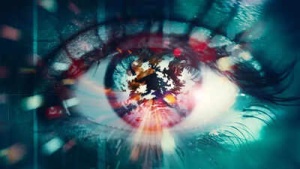Optical illusions are captivating the internet, providing a stimulating mental workout and a fantastic way to test your observational skills. These visual puzzles are not only entertaining but also offer a unique way to spend an evening. An optical illusion arises when our brain misinterprets what our eyes perceive.

This phenomenon occurs because the information transmitted by our eyes clashes with the brain's processing and understanding of visual input. These illusions often deceive us into seeing nonexistent elements or perceiving objects differently from reality. For instance, a static image might seem to be in motion, or two identical shapes might appear to be different sizes.
Take a look at the image filled with the word "pens." The repetition of the word, written in white against a black backdrop, is visually striking. However, there's a twist. Hidden within this array of "pens" is a different word, subtly camouflaged. Can you find it within 10 seconds?
Ready? Set? Go! Your time starts now.
Did you give up? The hidden word is "pan." Due to its similar spelling to "pen," it’s incredibly easy to overlook. We've highlighted the word to make it easier for you. Were you able to spot it on your own? Let us know in the comments.
There are primarily three categories of optical illusions:
Literal Illusions: These illusions occur when the brain pieces together elements of an image to create a perception of something that isn't actually there. For example, an image may be interpreted as either two faces or a vase.
Physiological Illusions: These illusions result from the overstimulation of the visual system. This can be triggered by excessive exposure to light, movement, or color, leading to effects like afterimages or motion illusions.
Cognitive Illusions: These illusions hinge on the brain's subconscious interpretation of information. A prime example is the Müller-Lyer illusion, where lines appear to be different lengths due to the surrounding shapes.
Newer articles
Older articles
 ‘Ghar ki murgi daal barabar’: Virender Sehwag’s son recalls father’s humorous words – Watch
‘Ghar ki murgi daal barabar’: Virender Sehwag’s son recalls father’s humorous words – Watch
 5 essential insects that protect your plants and reduce garden pests
5 essential insects that protect your plants and reduce garden pests
 Rishabh Pant Redefining Cricket, Says Greg Chappell
Rishabh Pant Redefining Cricket, Says Greg Chappell
 Warning Signs: 5 Prediabetes Symptoms to Watch For (No Blood Test Needed)
Warning Signs: 5 Prediabetes Symptoms to Watch For (No Blood Test Needed)
 Bangladesh Coach Simmons to Temporarily Leave Sri Lanka Tour for Medical Check-up
Bangladesh Coach Simmons to Temporarily Leave Sri Lanka Tour for Medical Check-up
 Sanjog Gupta Named New ICC Chief Executive Officer, Set to Lead Global Cricket Expansion
Sanjog Gupta Named New ICC Chief Executive Officer, Set to Lead Global Cricket Expansion
 SA20 Auction: Teams Allowed to Retain Up to Six Players Amidst Purse Increase and New RTM Card Introduction
SA20 Auction: Teams Allowed to Retain Up to Six Players Amidst Purse Increase and New RTM Card Introduction
 Elon Musk's first Neuralink implant allows paralysis patient to play games and…
Elon Musk's first Neuralink implant allows paralysis patient to play games and…
 Tiêu đề: Brain's Eye View: Study Shows We Perceive Reality 15 Seconds Late
Tiêu đề: Brain's Eye View: Study Shows We Perceive Reality 15 Seconds Late
 Udaipur: Unveiling India's Romantic "City of Lakes and Palaces"
Udaipur: Unveiling India's Romantic "City of Lakes and Palaces"